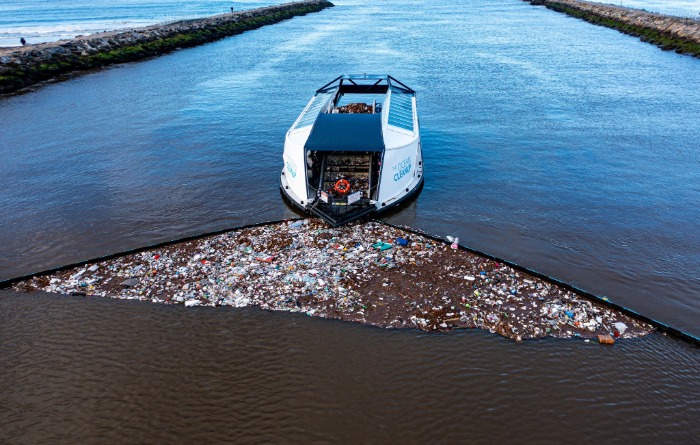Every year millions of tons of plastic enter the oceans. Solving this problem requires both reducing the inflows and cleaning up the accumulated plastic in our oceans. The Ocean Cleanup Project aims to reduce the “legacy” plastic by 90% in our oceans.
To accomplish this huge task, The Ocean Cleanup Project came up with a passive design that requires minimal energy to cover a large area of the ocean. The Ocean Cleanup technology has been designed to do the hard job of concentrating the plastic in one area for collection.
The system consists of a long floater (a 600-meter giant floating pipe) that sits at the surface of the water and a skirt that hangs beneath it. The floater provides buoyancy to the entire system while the skirt prevents debris from escaping underneath and leads it into the retention system.
The technology basically creates an artificial coastline in the middle of the ocean. Both the system and the plastic are being carried by the wind waves and current. However, to catch the plastics there needs to be a difference in speed between the system and the plastics. Hence, they use a sea anchor to slow down the system thereby concentrating the floating plastics inside the system.
The system autonomously navigates the “great pacific garbage patch” for extended periods of time catching and retaining plastic. Once it is full a vessel acting as a garbage truck will periodically remove the accumulated plastic. This is the result of years of research and testing. They have a plan to install 60 systems throughout the polluted oceans of the planet. The system is fitted with a solar powered system, cameras, lights, and sensors and satellite antennas to communicate its position all times.
The plastic is recycled and transformed into useful products, such as sunglasses made from 100% recycled plastic.
The Stock-flow situation
Soon after their successful mission, the Project realized they were dealing with a stock and flow situation. They were trying to clean a sink without changing the source, the plastic coming from the rivers into the ocean. This realization led to the idea of closing the tap (i.e. the rivers) from releasing plastic into the ocean. To accomplish this task, they came up with the river interceptors.
The River Interceptors
The interceptors are fully autonomous, 100% solar powered with a lithium-ion battery. Every interceptor can be monitored from a single central location. The interceptors are anchored to the riverbed and use the natural flow of rivers to capture plastic out of the rivers. The plastic floating on the river first encounters the barrier which guides the plastic to the mouth of the interceptor. Then the conveyor belt scopes the plastic out of the water. Next, the conveyor belt takes all the plastic, putting it into the six big dumpsters in the back of the interceptor. When all the dumpsters are full the interceptor will send a text message to the local operator to empty its dumpsters. The interceptor can extract 50,000 kg of trash a day, equivalent to 1 million soda bottles.
Currently there are interceptors cleaning rivers in Indonesia, Malaysia, Vietnam and the Dominican Republic. They have identified over 1000 rivers responsible for most of the plastic in our oceans. By closing the tap on these rivers from ejecting plastic, it will be more manageable to clean the ocean.
Additional Resources
Reach Out
We love talking about what we do and how it can make a difference to you.


